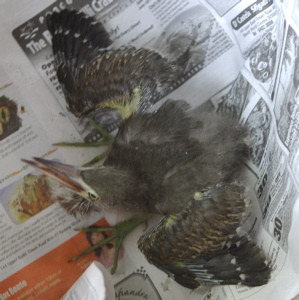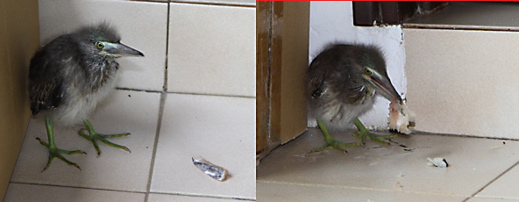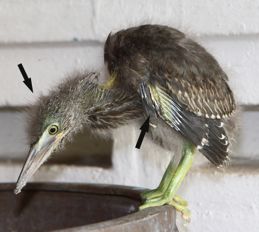On the evening of 2nd November 2007, Geraldine approached Morten Strange at the Botanic Garden Shop in the Visitors Centre, Singapore Botanic Gardens and informed that she and her husband Vincent had picked up a baby bird from the grounds of the Bukit Timah campus. As I was then nearby, I became the “expert” and ended up with the rescued chick.
I placed the chick inside a cardboard box and took it home (above). Not having any prior experience raising rescued chicks, I was naturally apprehensive of the new-found responsibility.
It was a heron, subsequently identified as Little Heron (Butorides striatus).
At home, I took out the piece of frozen fish I had in the refrigerator to defrost. The fillet was cut into small pieces and fed to the chick.
The bird was initially aggressive when I tried to feed it. It scolded me loudly – keek-keek-keek – and at the same time lunged at my hand with its long, sharp bill. Hunger must have got the better of it as it subsequently accepted a piece offered at the end of a pair of chopsticks. After a short interval I succeeded in feeding it two more pieces.
By nightfall it got used to me and stopped scolding and trying to peck my hand. It slept in the cardboard box, the top covered with newspapers.
The next morning I put it on a weighing machine – 100 g. It was a struggle to feed it as it again cried out loudly and lunged at my hand whenever it was offered fish. This time the gape looked wider than the night before and more intimidating. But ultimately it took a few pieces of fish. It was fed another two times that day, at times it even picked up the pieces from the ground. When I took it out of the box, it tried to hide behind the nearby flower pots. Chasing it out, I blocked its path with the box and it remained in a corner, staying still all the time, to eventually accepting a few more pieces of fish (above).
On the second morning the chick grew by 20% in weight to 120g. It had a hearty appetite, still feeding on fish. It refused earthworms though. It got more restless, climbing up from its confined space, this time a larger metal pot-holder.
It is definitely growing but the flight feathers have yet to develop, so it is not capable of flying, only walking. The image below shows the wing feathers that have yet to fully emerged from their sheaths (arrow). At the same time its numerous natal down – the soft down feathers covering the chick at around the time of hatching (below, arrow at head) – was shedding.
Herons lay a clutch of 3-7 eggs. Chicks are hatched naked and blind. They stay in the nest from 25 days among the smaller species to 13 weeks among the larger ones. Unfortunately I am not able to locate any nesting details on Little Heron. The chicks of herons are reported to wander off from the nest about half way through their growing period.
So this rescued chick could have wandered off and got lost. Or pushed off the nest by the more aggressive siblings. Whatever the cause, I can only speculate.
The chicks in a brood are reported to be intensely competitive for the food the parents bring. As egg hatching is asynchronous, the earlier-hatched are generally larger and will grab most of the food. The survival of the smaller chicks is often questionable. Also, there is widespread sibilicidal aggression among the chicks.
Stay tuned to learn what happen next!
In the meantime, if anyone has experience in raising heron chicks, please come forward. I keep the chick confined inside a container with the top covered as it can climb out and wander off and the neighbour’s cat may find it tempting. At the same time it is growing bigger and need to exercise.
YC Wee
Singapore
November 2007
References:.
1. Clark, G. A. Jr. (2004). [‘Form and function: The external bird.’]. Pp. 3.1-3.70 in Podulka, S., Rohrbaugh, R.W. Jr & Bonney, R. (eds.) Handbook of bird biology. Ithaca, NY: The Cornell Lab of Ornithology.
2. Martinez-Vilalta, A. & Motis, A. (1992). [‘Family Ardeidae (Herons)]. Pp. 376-429 in del Hoyo, J., Elliott, A. & Sargatal, J. (eds.) Handbook of the birds of the world. Vol. 1. Ostrich to ducks. Barcelona: Lynx Editions.












2 Responses
This is a fascinating story! I can’t wait to hear what happens, I hope things go well for the (adorable) little guy!